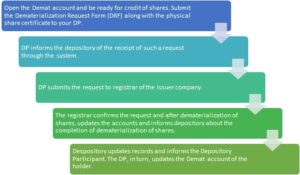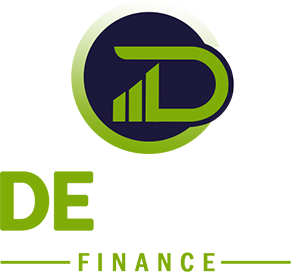Demat account, aka dematerialized account, holds the shares, securities, bonds, etc., in electric format. Dematerialization, or converting physical shares into electronic form, makes share trading easy and highly convenient. So here is all you want to know about the Demat account – What is a Demat account? How to open a Demat account? What are the benefits? What should you be aware of while opening a Demat?
A Demat account can hold the below range of securities in the electronic form:
- Shares and IPOs
- E-gold
- Bonds
- Government securities
- Exchange-traded funds
- Mutual funds
- Non-convertible debentures
The account shows the debit, credit, balance history of the above securities, just like a standard bank account would exhibit for the money held in it. Similarly, there is no lower limit to the value of securities you keep in a Demat account. In other words, you may choose to have a zero balance.
There are three parties to the whole process:
Depository
A depository is an organization that electronically holds securities of investors. The Depository has them at the request of the investors. Currently, there are two SEBI registered depositories. Central Depository Services Limited (CDSL) and National Securities Depository Limited (NSDL). These agencies electronically hold the pre-verified shares and provide Demat services through intermediaries.
A Depository Participant (DP)
DP is an agent through which the depository interfaces with the investors. Depository provides these services to investors through a depository participant.
Any financial institution registered with the SEBI can act as a depository participant. Such an institution acts as an agent of the Depository and helps execute transactions for the investors. In other words, a DP can be a financial institution, scheduled commercial or foreign bank operating in India, a stockbroker, a clearinghouse, a state finance corporation, a non-banking financial institution, etc. Each DP is assigned a unique code.
An investor
Any individual who owns securities is an investor. This person is the holder of the Demat account.
Benefits of a Demat account
Why do we require a Demat account and shares in electronic format?
The pressing need
Managing physical shares and related paperwork usually led to errors and mishappenings in the past. In addition, tracking original records and upkeep of transactions throughout the lifecycle of ownership was often very cumbersome. Furthermore, the volume of transactions was ever-increasing, and the authorities responsible were facing stress. Above all, any incorrect entry of rights could lead to several crippling effects, and the margin of error was not permissible.
In conclusion, these challenges were noticed and a need to revamp the entire process was felt. One outcome was to convert the ownership from manual to electronic form. Online holding was possible through a Demat account, and the process is called dematerialization.
There are many apparent benefits of dematerialization of shares:
- Conducting share transactions becomes very easy – managing holdings becomes simple as they reflect electronically in the account
- Multiple access options are possible when operated electronically. For instance, the holder can log in using a computer, laptop, smartphone, etc.
- Holding charges are minimal
- Electronic ownership is safe and secure, and the owner does not have to take care of a physical share certificate. Other risks like theft, loss, forgery, damage are also eliminated
- The margin of error is minimal as there is no manual record-keeping, like ownership entries, rights or bonus issuances, etc.
- Due to the elimination of manual intervention, it takes minimalistic time to complete and reflect changes on account of any transaction
- Pledging of shares to avail loan is still possible. Several lenders provide loans against securities held in the Demat account by using the online holdings as collateral
- The rights and obligations remain the same. In other words, the form of ownership (physical or electronic) does not impact the shareholder rights. For instance, the process around right shares, bonus shares, dividends, obtaining periodic information from the company, postal ballots, participate in meetings, etc. remains as is
- Address available with the depository participant gets registered with all the companies in which the investor holds securities electronically. Similarly, any change in address once reflected with the DP gets reflected in all the associated company records. It is immensely beneficial and eliminates the need to correspond individually
- Transmission of shares happens through the DP, and there is no need for communication with sellers, issuer companies, etc.
How to open a Demat account, and documents required
Here is a guide to open a Demat account and an overview of the documents required
Open a Demat account physically
Below is a step-by-step guide to open a Demat account.
Select the depository participant
The platforms the DPs offer are pretty advanced. However, the charges and services differ at the same time. Therefore, once you have compared the services, costs, and benefits, you must finalize the DP suitable to your requirements.
Documentation requirements
The next step is to fill in the Demat application form and submit the KYC documents. Opening a Demat account is quite similar to opening a bank account. And, therefore, the documentation requirements are pretty similar as well. The documents required are:
- Proof of identity
- Address proof
- Income proof
- Bank account statement
- Permanent Account Number (PAN) card
- Passport size photographs
Verification process
Similar to a bank account, the depository participant may verify the KYC documents submitted as proof. Also, DP may conduct an in-person verification. Along with the application process, the applicant must agree to the list of trading rules and regulations.
You may be required to pay an account opening fee, which differs from one DP to the other.
Final approval
Once the verification, in-person and documents, is completed and found satisfactory, the account gets approved. The Demat account is now open, and a unique identification number gets assigned to your account. You will get a final communication stating the unique number.
Open a Demat account online
We described the process to open the Demat account physically. However, there is an even more convenient way to open a Demat account: do it online. The process is simple for those equipped and well-versed with a computer, laptop, tablet, or smartphone.
One can open a Demat account online. Here are the steps:
- Visit the official website of the selected depository participant (DP)
- Fill out the necessary details in a simple form online, and you will have to verify the mobile number with a one-time password (OTP)
- The KYC details, like date of birth, PAN card details, contact, and bank account details, will need to be provided
- The Demat is open for use, and you will receive the necessary details over email and on mobile phone
Types of Demat account
Essentially, there are three types of Demat accounts. The category depends on the residential status of the investor:
Regular Demat account
This Demat account is available to all the investors in India. Therefore, one can approach a depository participant (DP) of choice and open a Demat account.
Repatriable account
A repatriable Demat account allows the international transfer of funds. Non-resident Indians (NRIs) who hold a non-resident rupee account (NRE) can open this type of Demat account.
Non-repatriable account
A non-resident Indian with a non-resident ordinary (NRO) rupee account can open this Demat account. However, this type of Demat account does not allow for any international transfer of funds.
Can an investor open multiple accounts?
Yes, an investor can open multiple accounts. For example, the investor can open the holding account in the same name, with the same DP or different DP’s.
The investor must comply with the KYC norms for all the accounts, including Proof of Identity and Proof of Address requirements as stipulated by SEBI and provide a PAN number. In addition, the investor must show the original PAN card at the time of opening of Demat account.
The ownership pattern of Demat account and securities must be the same. So, for instance, if one share certificate is in the individual name and another is joint, in that case, two different accounts would have to be opened.
Know this before opening a Demat account?
The process to open the Demat account is straightforward. However, for new investors, it is vital to remain mindful of specific points:
Link the Demat account to the trading account
A Demat account is like a bank account that holds your securities. In addition, however, you need a trading account to execute sale and purchase transactions. To successfully use both the Demat and trading account, they should be linked.
Check correctness of personal information
When you open the account, please double-check the information provided. Any error in the details can lead to the rejection of the application. Further, an incorrect mobile number or email id, will not allow you to get the necessary information.
Know the costs/charges
The transaction charges vary per depository participant. In other words, the nature of services determines the charges levied. Based on the volume of your transactions and the nature of services, you must wisely choose the broker.
Add a nominee
One aspect, often ignored, is adding the name of a nominee. To have a nominee added will avoid many hassles in the future. In addition, a nomination, once made, can be changed at a later date as desired by the account holder.
Only individuals can nominate. Nomination is possible both singly and jointly. Non-individuals, trust, body corporate, society, Karta of a HUF (Hindu Undivided Family), holder of power of attorney cannot nominate.
Only an individual can become a nominee. In other words, society, trust, body corporate, partnership firm, Karta of HUF or a power of attorney holder cannot be a nominee.
Opt for notifications and remain vigilant
Depository participants send a lot of information via emails and SMS. Therefore, account-holders must remain vigilant and check the updates on transactions conducted in the account regularly. These accounts are generally safe but are not free from fraudulent attacks. Therefore, the account holder’s responsibility is to keep track of activities and ensure only valid and approved transactions get reflected in the account.
What is dematerialization? How to convert physical shares to electronic?
Dematerialization is the process of how physical share certificates get converted into an equivalent number of securities in electronic form. These shares get credited into the Demat account of the beneficial owner. Here is a quick summary of how to dematerialize physical shares:

Can electronic shares be converted back to physical format?
Yes, and the process is called Rematerialization. The process is very similar to the dematerialization process, while the outcome is the opposite. Herein, the holder submits shares in an electronic format and, in turn, receives physical share certificates at the end of the process.
Important frequently asked questions
Here are some of the important frequently asked questions.
Is the name change of the beneficial owner permitted after opening the account?
Yes, an individual owner can change the name in the event of a marriage, change the father’s name, and other reasons by submitting publication of name change in the official gazette.
Can you close a DP account and transfer shares to another?
Yes. An investor can submit an account closure request form to the DP. Then, based on the instructions received, the DP will transfer all the existing shares lying in the account to another account. After that, the DP will close the account.
What happens if there are discrepancies in holdings?
In case of any discrepancy, the investor can contact the DP. In case of any issue in the corporate benefits, the owner can reach out to the issuer company. If discrepancies are still unresolved, the investor can reach out to CDSL or NSDL.
Can odd lot share be dematerialized?
Yes, odd lots share certificates can get dematerialized.
Is it possible to get public offerings directly credited in electronic form?
Yes, it is possible to get IPO securities directly credited to the Demat account. In addition, the IPO forms have an option to indicate how to allot the shares.
What is the transmission of shares?
Transmission of shares is when securities of a deceased account holder get transferred to the account of legal heirs/nominees. The transmission process is more straightforward in the case of dematerialized holdings. One can initiate the transmission by submitting relevant documents to the DP. However, in the case of physical securities, the legal heirs/nominee/surviving joint holder must independently correspond with each company in which the owner held securities.
What is the process of transmission of shares?
The claimant must submit to the concerned DP an application, i.e. Transmission Request Form (TRF), along with the following documents:
- In the case of death of sole holder; where the sole holder has appointed a nominee
- a notarized copy of the death certificate
- In the case of death of the sole holder; where the sole holder has not specified a nominee
- Notarized copy of the death certificate
- And, any one of the following documents:
- Succession certificate
- Copy of probated will
- Letter of Administration
The depository participant must ensure that the application is genuine before transferring securities to the claimant’s account.
The transmission process is more straightforward in the case of dematerialized holdings. One can initiate the transmission by submitting relevant documents to the DP. In the case of physical securities, the legal heirs/nominee/surviving joint holder must independently correspond with each company in which the owner held securities.
We hope this article provided insights into what is a Demat account, its benefits, facts to be aware of and some of the frequently asked questions.
Happy investing!
About the author
The author is a senior finance professional with over fifteen years of work experience in corporate finance. He has an affinity for matters relating to personal finance and investment management. Through his writing, the author wants to share his knowledge and understanding of the subject.
Please leave your comment or share thoughts on this article via email at decodefinance.in@gmail.com. For more articles, please visit the website www.decodefinance.in.
Disclaimer
The author has used his knowledge, experience, and understanding of the subject and has exercised extreme caution to avoid possible mistakes. However, the author does not take any responsibility for any error that exists.
Any views, opinions, and thoughts mentioned in the article belong solely to the author and not necessarily to the author’s employer (past or current), organization, committee, or other group or individual.
Under any circumstances, the author shall not be liable for any views or analysis expressed in this note. Further, the opinions expressed are not binding on any authority or Court. We advise readers to consult their financial advisor for assistance in their specific case.




